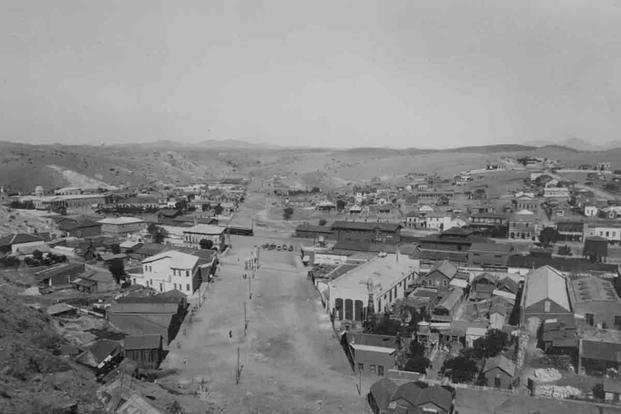It was late afternoon on a blazing August day in 1918. Zeferino Gil Lamadrid was on his way home from doing some business on the Arizona side of the Nogales, a city that straddles the border between the Mexican state of Sonora and American Arizona. He carried a package but didn’t stop at the U.S. customs house along International Street, which ran between the two towns.
Longtime residents often crossed from one side of the border to the other without a second thought. That day, however, would be different. The simple act of crossing the street would nearly spark a shooting war between Mexico and the United States.
It was Aug. 27, 1918, and the United States was at war against the German Empire and its allies. A series of uprisings and rebellions against Mexico’s federal government began in 1910, and violence occasionally poured over the border. Tensions on the border mounted when the U.S. occupied the Mexican city of Veracruz in 1914, Mexican revolutionary Pancho Villa began raiding American towns in the Southwest and the U.S. Army responded by entering Mexico in a failed attempt to hunt down Villa.
Read Next: Military to Take Over Federal Land Along Border Under New Trump Order
The U.S. began reinforcing border towns with armed troops as American officials, including the local field commanders, increasingly suspected Germany was advising Mexican forces and agitating for violence. Racial and political tensions were both very high, and nowhere was that more apparent than in Nogales.

So it’s no surprise that a series of confusing events that day led to an American infantryman firing his rifle at a carpenter, the death of Nogales’ Mexican mayor and, eventually, the first permanent fence built to keep people from freely crossing the border between the two countries.
The bad blood at the border didn’t start in Nogales. Mexico and the United States clashed long before the Texas border was established. The two went to war in 1846 over a strip of desert between the Rio Grande and Nueces rivers, a border dispute that went well beyond that slice of territory. Texas had joined the United States while Mexico never recognized that Texas was independent of Mexico in the first place.
By 1909, destiny had been manifested, the U.S. stretched from sea to shining sea and the frontier was closed. There were no southern border disputes -- none that should have led to a shooting war anyway. In Nogales, no one needed a border fence. The wide boulevard Calle Internacional-International Street was enough -- until it wasn’t.
The first fence between the countries was actually built in 1911 when the Bureau of Animal Industry needed to keep Mexican cattle from entering California to prevent the spread of cattle tick diseases. Other fences had been constructed along the border, but it was only after what turned into the Battle of Ambos Nogales (“both Nogales”) that the separation started to become permanent.

As Zeferino Gil Lamadrid walked across International Street (and thus the U.S.-Mexico border), American inspector Arthur G. Barber called out to him to come back and get his package inspected. Lamadrid had already crossed the border, and the Mexican customs official shouted to him to stay in Mexico. The carpenter paused, understandably confused and unsure of what to do next. That’s when a shot rang out. Pvt. William Klint of the U.S. 35th Infantry fired a warning shot from his service rifle.
The carpenter, hearing the shot, threw himself on the ground. Mexican customs officer Francisco Gallegos, believing the soldier just killed a civilian, drew his weapon and shot Pvt. Klint in the face (some historians say he was killed, but the 35th Infantry history page refutes that). The American custom inspectors drew their pistols and returned fire, killing Gallegos and fellow officer Andrés Ceceña. Amid the shooting, Zeferino Gil Lamadrid fled the scene.
As the cracks of gunfire filled the air in and around Ambos Nogales, Mexican citizens ran home to grab their rifles and join the Mexican troops. The Mexicans occupied the stone-built home of future president Alvaro Obregon as a strongpoint. Buffalo Soldiers of the U.S. 10th Cavalry, stationed just north of Nogales, moved to capture the hills overlooking the town and linked up with the garrison from the 35th Infantry. Together, they moved across the border into Mexico as the Americans mounted a machine gun from the rooftops of the buildings across International Street.
The mayor of Mexican Nogales, Felix B. Peñaloza, tied a white handkerchief to his cane and walked into the street to implore his citizens to stop shooting. He was shot from the Arizona side of the border, according to most sources. Lt. Col Frederick J. Herman, commander of the 10th Cavalry at Nogales, denied that it came from one of his soldiers, but it wasn’t long before American civilians had joined the firefight. The ammo exchange lasted for more than three hours before the Mexicans flew a white flag from their customs house and Herman ordered a ceasefire.

On the U.S. side, four were dead and 29 were wounded. Mexico reported 15 deaths. Both sides of the conflict expressed regret at the shooting, but much of the blame was placed on an unnamed U.S. customs inspector, whose behavior toward the Mexicans caused much of the outrage from the Sonoran side of the border. The inspector was fired, and both countries apologized for their role in the Battle of Ambos Nogales. To prevent further animosity, a two-mile border fence was constructed down the center of International Street, the first permanent structure separating the people of the two nations.
Want to Learn More About Military Life?
Whether you're thinking of joining the military, looking for post-military careers or keeping up with military life and benefits, Military.com has you covered. Subscribe to Military.com to have military news, updates and resources delivered directly to your inbox.















